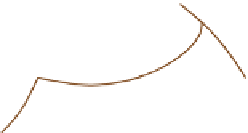Geoscience Reference
In-Depth Information
decrease by 10-20mb in 12-24 hours as the system
intensifies. This is possible because upper-air
divergence removes rising air more quickly
than convergence at lower levels replaces it (see
Figure 5.7
). The superimposition of a region of
upper divergence over a frontal zone is the prime
motivating force of
cyclogenesis
(i.e., depression
formation).
The long (or Rossby) waves in the middle and
upper troposphere, discussed in Chapter 7A.2,
are particularly important in this respect. The
latitudinal circumference limits the circumpolar
westerly flow to between three and six major
Rossby waves, and these affect the formation and
movement of surface depressions. Two primary
stationary waves tend to be located about 70
°
W
and 150
E in response to the influence on the
atmospheric circulation of orographic barriers,
such as the Rocky Mountains and the Tibetan
plateau, and of heat sources. On the eastern limb
of troughs in the upper westerlies of the Northern
Hemisphere the flow is normally divergent,
since the gradient wind is subgeostrophic in the
trough but supergeostrophic in the ridge (see
Chapter 6A.4). Thus, the sector ahead of an upper
trough is a very favorable location for a surface
depression to form or deepen (see
Figure 9.22
). It
will be noted that the mean upper troughs are
significantly positioned just west of the Atlantic
and Pacific Polar Front Zones in winter.
With these ideas in mind, we can examine the
three-dimensional nature of depression develop-
ment and the links existing between upper and
lower tropospheric flow. The basic theory relates
to the vorticity equation, which states that, for
frictionless horizontal motion, the rate of change
of the vertical component of absolute vorticity
(d
Q
/d
t
or d(
f
+
°
300mb
VN
D
9km
C
VX
300mb
S
R
R
R
H
L
9km
C
D
SURFACE
SURFACE
Surface isobars
Rossby waves at 300mb
Vertical motions
Rising
Sinking
C
Convergence
Divergence
Maximum vorticity
Minimum vorticity
Positive and
negative vorticity
D
VX
VN
+
-
R
S
Figure 9.22
Schematic representation of the
relationship between surface pressure (H and L),
airflow and frontal systems, on the one hand, and
the location of troughs and ridges in the Rossby
waves at the 300mb level. The locations of
maximum (cyclonic) and minimum (anticyclonic)
relative vorticity are shown, as are those of
negative (anticyclonic) and positive (cyclonic)
vorticity advection.
Sources: Mostly after Musk (1988), with additions from
Uccellini (1990). Courtesy of Cambridge University Press.
)/d
t
) is proportional to air-mass
convergence (-
D
, i.e., negative divergence):
ζ
d
Q
1
Q
--- =
DQ
or
D
= - -- ---
d
t
Q
d
t
The relationship implies that a converging
(diverging) air column has increasing (decreasing)
absolute vorticity. The conservation of vorticity
equation, which we have already discussed, is in
fact a special case of this relationship.
In the sector ahead of an upper trough, the
decreasing cyclonic vorticity causes divergence
(i.e.,
D
positive), since the change in ζ outweighs
that in
f
, thereby favoring surface convergence
and low-level cyclonic vorticity (see
Figure 9.23
).
Once the surface cyclonic circulation has become
established, vorticity production is increased
through the effects of thermal advection. Pole-
ward transport of warm air in the warm sector and
v
DIV
CON
300mb
JET
STREAM
DIV
CON
Surface
front
o
i
Figure 9.23
Model of the jet stream and surface fronts,
showing zones of upper tropospheric divergence and
convergence and the jet stream cores.













































































